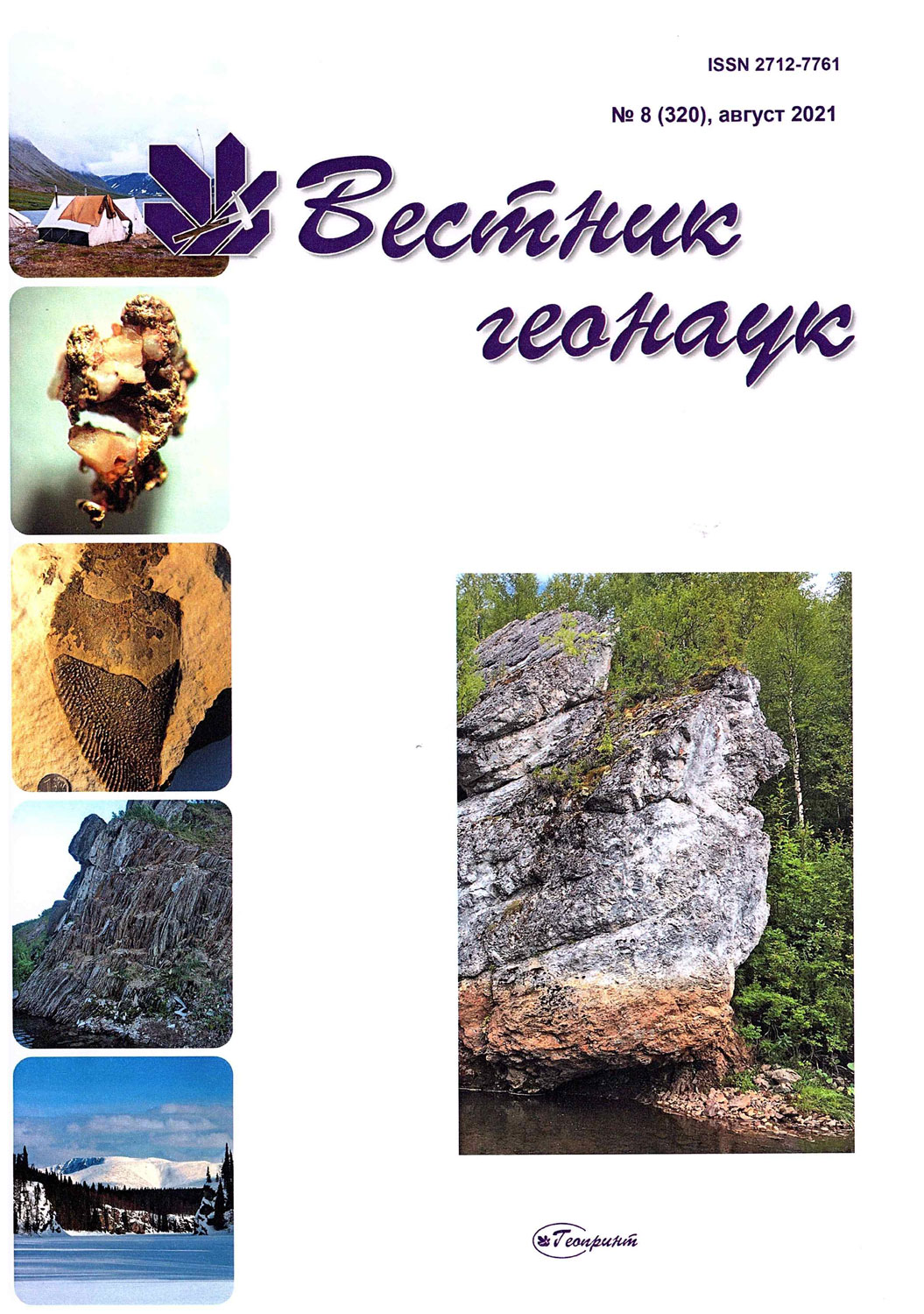|
Title page
|
1
|
|
Content
|
2
|
| |
|
|
Scientific articles
|
|
|
Typomorphism of сhromespinelides from the Holocene psephites
of the Kyvvozhskoye gold-placer field
(Volsko-Vymskaya ridge, Middle Timan)
Yu. V. Glukhov, B. A. Makeev, M. Yu. Sokerin
DOI: 10.19110/geov.2021.8.1
The results of the study of accessory chrome spinels from heavy mineral concentrates of gold-bearing psephites of the Kyvvozhsky gold-placer field (Volsko-Vymskaya ridge, Middle Timan) are presented. As a result of the study of the typochemistry of chromspinelides, their genetic relationship with rocks of mainly alkaline-ultrabasic composition — analogues of Timanian Late-Riphean-Vendian ultramafites and Early-Middle Devonian alnoites is substantiated. The formation of magmatic sources of chrome spinels occurred in a wide range of geotectonic settings — from passive (platform) to active (island-arc subduction zones), which are more characteristic of the bulk of chrome spinels. The crystallization of chrome spinels, found as microinclusions in lherzolite pyropes in the same shlich samples of the Kyvvozhskaya gold-bearing area, is associated with the conditions of rift zones (spreading of the seabed). We made a conclusion about probable local (intra-valley) position of main magmatic sources of chrome spinels. The revealed chrome spinels, containing microinclusions of nickel and copper sulfides, are considered by the authors as indicators of igneous rocks containing platinum group minerals.
Keywords: chrome spinel, Kyvvozhsky gold-placer field, Vol’sko-Vymsky ridge, Middle Timan.
 Download full text Download full text
|
3—15
|
|
|
Nano- and micromorphological evidences
of the colloidal structure
of ring silicate crystal inclusions
N. N. Piskunova, A. A. Kryazhev
DOI: 10.19110/geov.2021.8.2
The substance released naturally during mechanical opening of growth inclusions of aquamarine, beryl and tourmaline crystals (Transbaikalia, Russia) has been studied by scanning atomic force microscopy (AFM) and electron microscopy (SEM). The liquid part of the substance of the inclusions is a sufficiently concentrated colloidal sol-gel-silicate system. The diffused silicate colloid forms a film, poorly removable from the chip surface, which is reliably detected by AFM and transformed under prolonged exposure to an electron beam into a foam-glass. The latter fact can be used to create sub-micron textures that are stable under normal conditions by electron-beam lithography. The study of quartz and phenacite (Ural, Russia) did not reveal such films. In contrast to aquamarine, the inner walls of cavities of quartz and phenacite inclusions, according to AFM data, are covered with growth hills, grown by the dislocation mechanism. This indicates a relatively low degree of polymerization of the silicate component in the initial hydrothermal mother liquor for quartz and phenacite compared to the degree of polymerization in the mineral-forming media of ring silicate crystals.
Keywords: atomic force microscopy, fluid inclusions, sol-gel, foam-glass, Sherlovaya Mountain.
 Download full text Download full text
|
16—26
|
|
|
Industrial brines of the Khoreyver depression
of the Pech ora plate
T. P. Mityusheva, O. Ye. Amosova
DOI: 10.19110/geov.2021.8.3
We studied areal distribution of the Khoreyver depression and strontium and lithium-rich iodine-bromine and iodine-boron industrial brines in the hydrogeological section. We presented the potential of the territory for practical use of industrial sodium chloride and calcium-sodium underground brines in the maps of distribution of bromine, iodine, boron and strontium-lithium iodinebromine and iodine-boric industrial brines within three Paleozoic calcareous aquifers (O2–S–D1; D3–C1; C–P1). Separate areas with lithium-strontium iodine - bromine and iodine-boric standard quality brines are designated.
Keywords: industrial brines, bromine, iodine, boron, lithium, strontium, aquifers, Khoreyver depression.
 Download full text Download full text
|
27—45
|
|
|
Amphiboles of high-pressure metabasites
of the Mica hill region (Polar Urals, Marun-Keu range)
from the collection of A. A. Chernov Geological museum
I. S. Astakhova, K. S. Popvasev
|
46—54
|
| |
|
|
Chronicle, events, facts
|
| |
|
|
«Small geological ring of the Komi Republic» field trip
 Download text Download text
|
55—56 |
|
|













